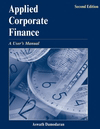This project covers everything we will be doing in class. I
have listed some of the key questions that you will be answering and the
of the class that these questions relate to. Note that these questions are
not meant to be comprehensive and you can add on interesting questions that
you come up with. You can also check to see where you are in terms of the time
frame for this project.
| Topic |
Key Questions |
Sessions |
| I. Corporate Governance Analysis |
- Is this a company where there is a separation between management
and ownership? If so, how responsive is management to stockholders?
- How does this firm interact with financial markets? How do markets
get information on the firm?
- How does this firm view its social obligations and manage its image
in society?
|
1-4 |
| II. Stockholder Analysis |
- Who is the average investor in this stock? (Individual or pension
fund, taxable or tax-exempt, small or large, domestic or foreign)
- Who is the marginal investor in this stock?
|
5 |
| III. Risk and Return |
- What is the risk profile of your company? (How much overall risk
is there in this firm? Where is this risk coming from (market, firm,
industry or currency)? How is the risk profile changing?)
- What is the performance profile of an investment in this company?
What return would you have earned investing in this company's stock?
Would you have under or out performed the market? How much of the
performance can be attributed to management?
- How risky is this company's equity? Why? What is its cost of equity?
- How risky is this company's debt? What is its cost of debt?
- What is this company's current cost of capital?
|
6-12 |
| IV. Measuring Investment Returns |
- Is there a typical project for this firm? If yes, what would it
look like in terms of life(long term or short term), investment needs
and cash flow patterns?
- How good are the projects that the company has on its books currently?
- Are the projects in the future likely to look like the projects
in the past? Why or why not?
|
13-16 |
| V. Capital Structure Choices |
- What are the different kinds or types of financing that this company
has used to raise funds? Where do they fall in the continuum between
debt and equity?
- How large, in qualitative or quantitative terms, are the advantages
to this company from using debt?
- How large, in qualitative or quantitative terms, are the disadvantages
to this company from using debt?
- From the qualitative trade off, does this firm look like it has
too much or too little debt?
|
17 |
| VI. Optimal Capital Structure |
- Based upon the cost of capital approach, what is the optimal debt
ratio for your firm?
- Bringing in reasonable constraints into the decision process, what
would your recommended debt ratio be for this firm?
- Does your firm have too much or too little debt
- relative to the sector?
- relative to the market?
|
18-19 |
| VII. Mechanics of Moving to the Optimal |
If your firm's actual debt ratio is different from its ìrecommended" debt
ratio, how should they get from the actual to the optimal? In particular,
- should they do it gradually over time or should they do it right
now?
- should they alter their existing mix (by buying back stock or retiring
debt) or should they take new projects with debt or equity?
- What type of financing should this firm use? In particular,
- should it be short term or long term?
- what currency should it be in?
- what special features should the financing have?
|
20-21 |
| VIII. Dividend Policy |
- How has this company returned cash to its owners? Has it paid dividends,
bought back stock or spun off assets?
- Given this firm's characteristics today, how would you recommend
that they return cash to stockholders (assuming that they have excess
cash)?
|
22 |
| IX. A Framework for Analyzing Dividends |
- How much could this firm have returned to its stockholders over
the last few years? How much did it actually return?
- Given this dividend policy and the current cash balance of this
firm, would you push the firm to change its dividend policy (return
more or less cash to its owners)?
- How does this firm's dividend policy compare to those of its peer
group and to the rest of the market?
|
23-24 |
| X. Valuation |
- What type of cash flow (dividends, FCFE or FCFF) would you choose
to discount for this firm?
- What growth pattern (Stable, 2-stage, 3-stage) would you pick for
this firm? How long will high growth last?
- What is your estimate of value of equity in this firm? How does
this compare to the market value?
- What is the "key variable" (risk, growth, leverage, profit
margins...) driving this value?
- If you were hired to enhance value at this firm, what would be
the path you would choose?
|
25 |

